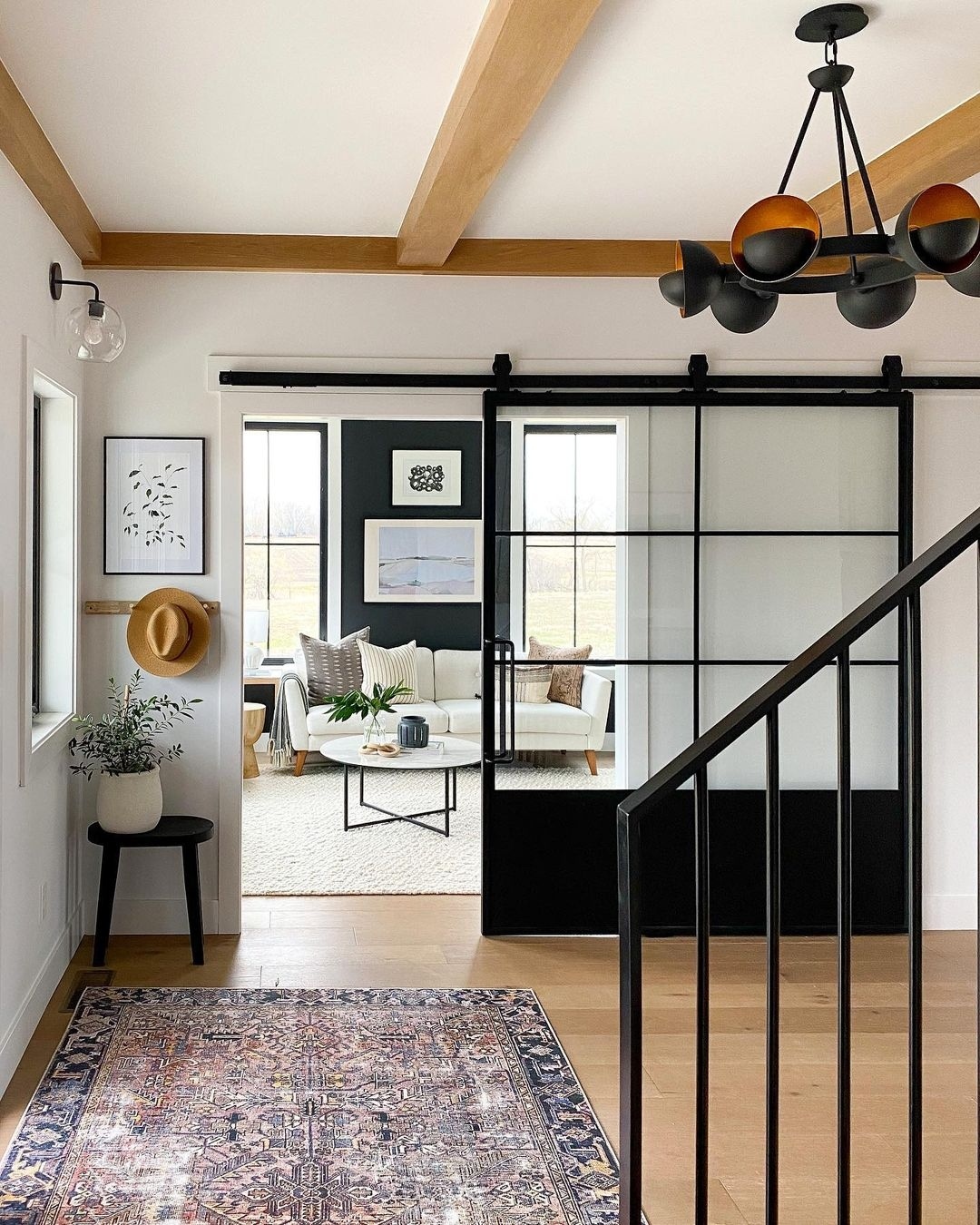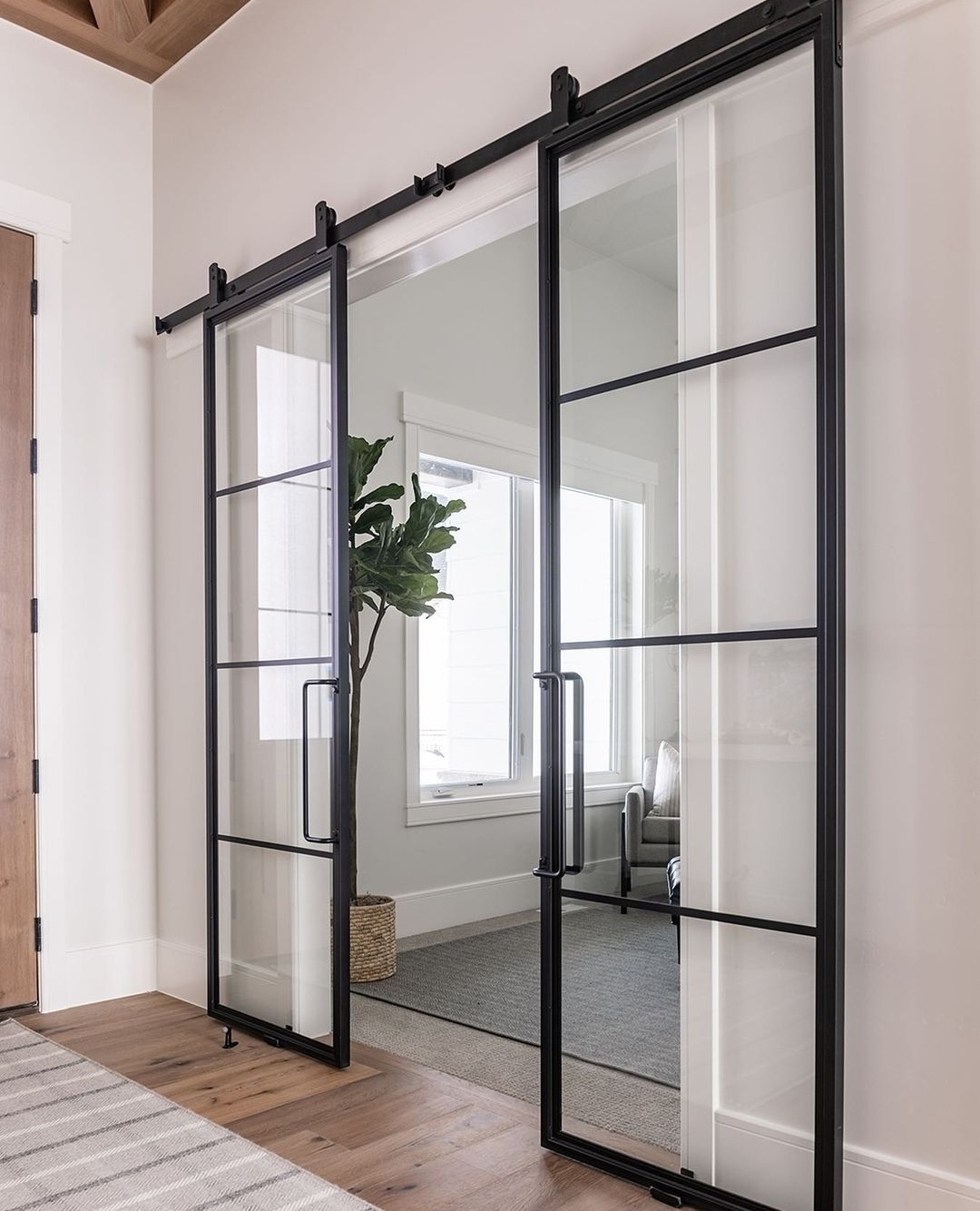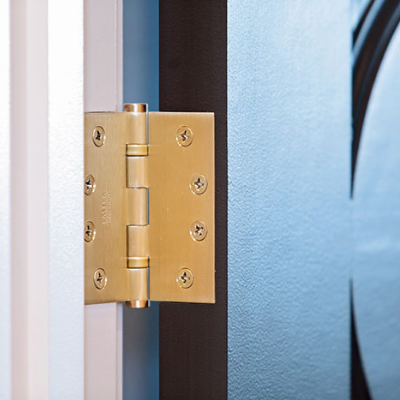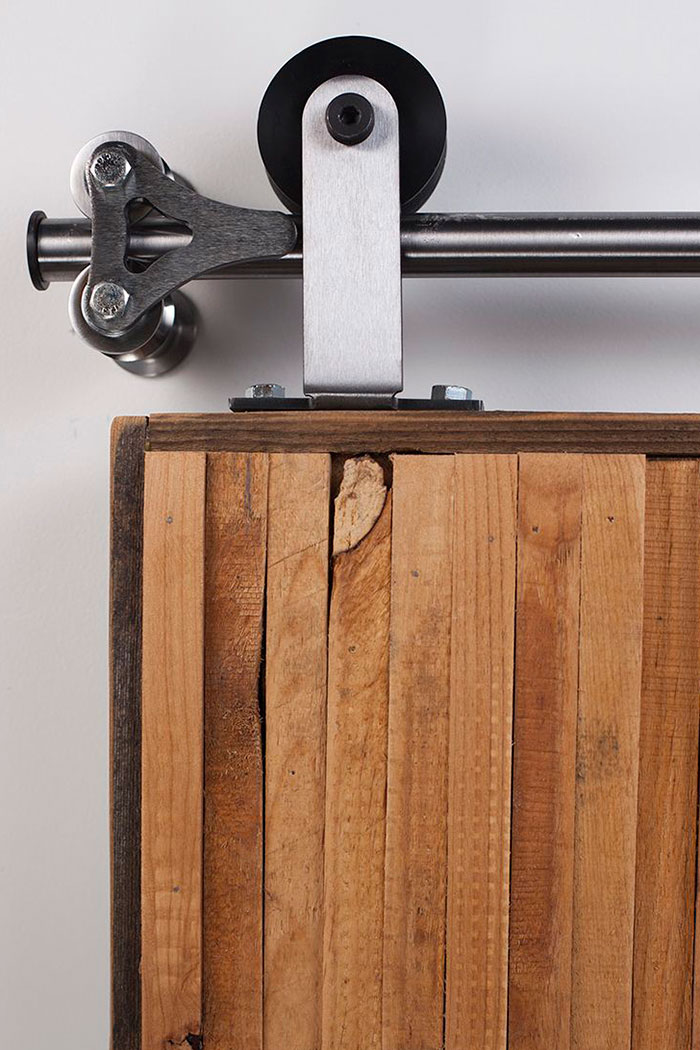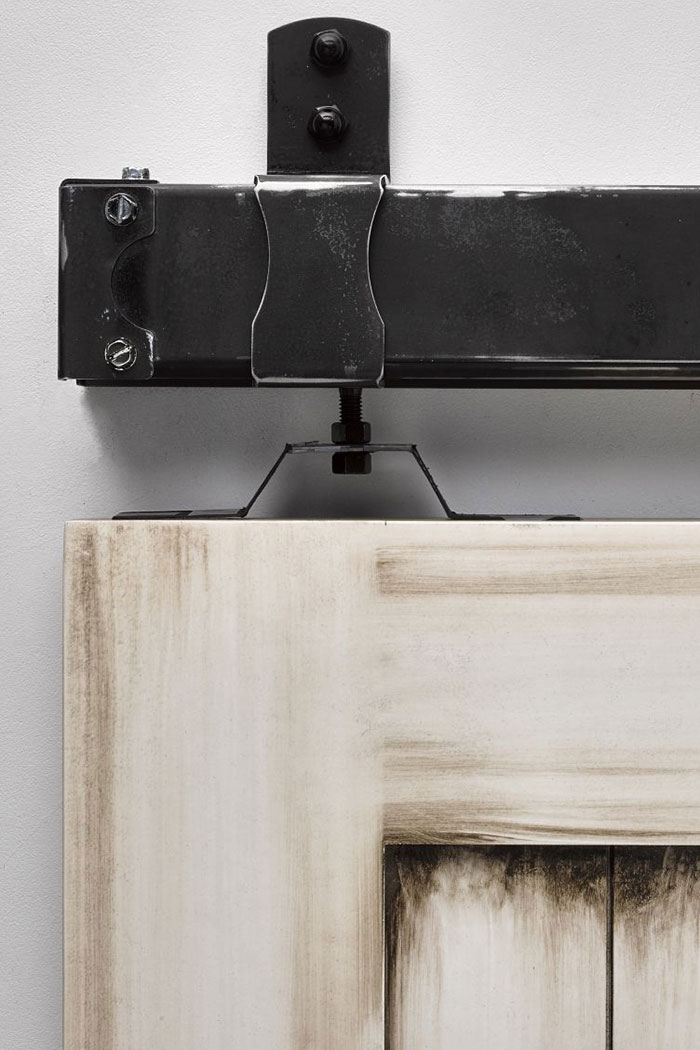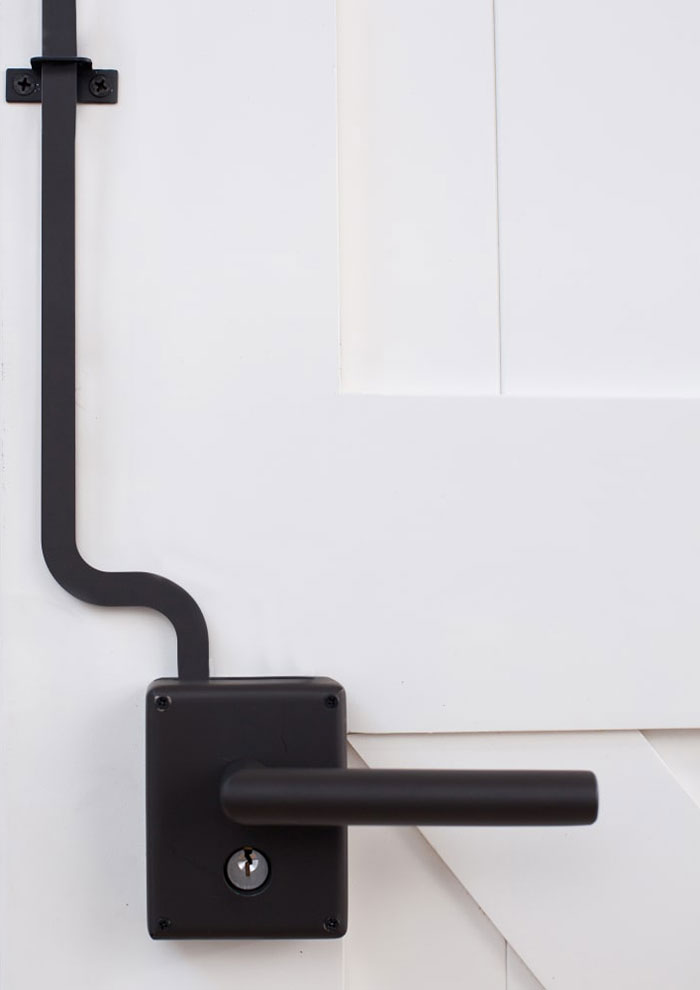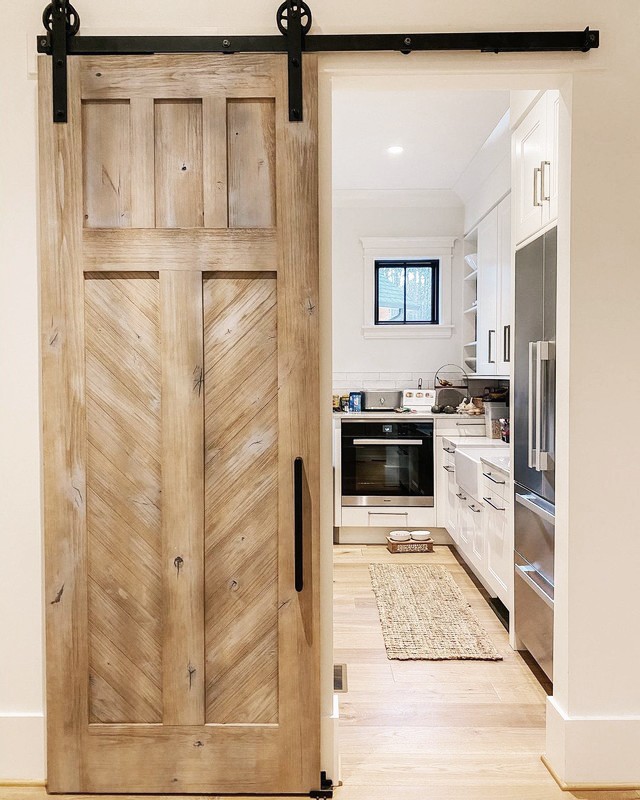Interior doors are a gateway into the rooms of our life. Whether they lead into a den or study, a
child’s playroom, a sunroom, or a guest bedroom, they contribute to the overall ambiance we try to establish in our
home. Decorating goes far in creating the vibe in our homes, but interior door hardware contributes and ties it all
together. A few pieces of hardware to specifically focus on include:
6 Interior Door Hardware Options to Consider
- Doorknobs and Handles
- Door Locks
- Door Hinges
- Sliding Door Tracks
- Sliding Door Floor Guide
- Sliding Door Locks and Handles
Interior door hardware should never be overlooked when it comes to planning out the perfect style and feel for
every room in the house. If done right, these pieces of hardware will become items of functional decor; contributing
to the beauty, functionality, and design you envision.
How to Choose Interior Door Hardware
Choosing interior door hardware might be one of the last steps you take
as you put the finishing touches on a new build, remodel, or renovation. That doesn’t mean it’s the least important,
though! There’s a lot that goes into choosing your interior door hardware, such as its function, color, design, and
size. You’ll also need to consider the
types of doors
you have. Interior barn door hardware, for example, is going to be significantly different than interior double door
hardware. Here are a few tips to keep in mind:
Function: Does your
door need to lock and swing or latch and slide? Will it need a track to roll, or does it require heavy-duty hinges
because it’s an
oversized or
custom-order swing door? These are important considerations to keep in mind while shopping.
Color: The color of hardware can go a long way toward matching or distracting from
the look and feel you’ve worked to create. If you want hardware that will fade into a dark-colored door or pop
against a light-colored door, choose black interior door hardware or a darker color. For hardware accents that don’t
draw attention, choose silver. Gold tends to pop, so colored hardware should be matched carefully with the
surrounding colors; crystal doorknobs will lend an air of elegance and charm.
Design: What design is your door inspired by? Choose hardware that matches the look and feel.
Interior
French door
hardware will look much different than interior
sliding door
hardware, so consider the look and feel of the door itself.
Size: While
standard sizes
work for most doors, you should keep in mind that a
custom size door
will generally need custom hardware sized to fit it.
1. Doorknobs and Handles
Function: Function is the most important consideration when
choosing a doorknob or door handle. Consider where the knob is going. A round knob is harder for children and those
with arthritic hands to open. Oval knobs are slightly easier to open, but lever handles are the easiest of all. Oval
knobs provide a more vintage feel, while a lever handle provides a modern touch. If you’re choosing a dummy door
knob (a doorknob that doesn’t have any purposeful function), then you can choose whatever hardware style you prefer.
Color: The color of your doorknob can go a long way toward
complementing the color scheme and style you’ve created in your home. In general, gold doorknobs leave the home
feeling a bit dated unless they’re an updated knob style. Silver goes well with nearly any color scheme, while matte
black and oil rubbed bronze pair well with
farmhouse,
modern, and rustic styles. Use crystal doorknobs sparingly and only when you’re certain the look will benefit your
hardware style and not look too over-the-top.
Design: Interior door
hardware trends are always evolving. What’s important to remember is that the design you choose should go with
your house. The coolest, minimalist doorknob that just hit the market may not pair well with a shabby chic
home. The crystal-style doorknob probably won’t mesh with an industrial loft. You get the idea. Pick a doorknob that
complements the other design concepts within the space.
Size:
Sizing is key. Make sure you measure the borehole to match the correct size for your doorknob before ordering. The
knob must fit properly, otherwise, it won’t work. If you measure incorrectly, at best you’ll need to widen the
borehole. At worst, the hole will be too large, your knob too small, and you’ll need to reorder the item entirely.
This is true for
handles and other
parts of sliding interior door hardware, as well. Like a swinging interior doorknob, an interior barn door hardware
kit isn’t universal but many come with standard sizing. That’s why it’s crucial to measure the size of the door
handle and other hardware pieces you need. Imagine forgetting this step and receiving cabinet-sized interior barn
door sliding hardware instead of full-sized sliding hardware for your closet door or entry to your master bedroom.
If you’re installing a keyed entry door knob on a private office or study interior
door, there are going to be specific measurement requirements. Be sure to read the product description and measure
your door for a proper fit.
2. Door Locks
Locks are something you’ll want to give yourself ample time to think over and figure out. Just
because you’re not updating an exterior door, doesn’t mean you won’t want locks. Many rooms, such as master
bedrooms, offices, studies, and wine cellars, might need locks for safety or security. Thankfully, whether you want
to install rustic interior door hardware or something with a modern look, many come with locking options.
Function: The function of your lock is a great place to start when
determining which lock you want. Door knobs with a twist lock or push lock on one side often need a key on the
other. These are often utilized for an exterior door because they require keys. A privacy door knob is favored for
bathrooms and bedrooms because they have a failsafe unlock option. Door locks that feature keypads provide extra
security, whereas some door handles that feature a key lock can easily be opened from the inside by turning the
handle to open. A French door locking mechanism will ensure your double doors stay tightly closed until you open
them by turning the lock or turning the handles, depending on the lock setup.
Color: Just like the doorknob and handle, locks come in a variety of sizes. To determine which one
you need, choose a color that will complement your door color and the vibe within the home. Matte black and rubbed
oil bronze work exceptionally well in rustic, shabby chic, and some modern homes. Stainless steel, brushed nickel,
or various color locks work well in more modern homes.
Design: The
design of your lock will be closely linked to the function of your doorknob. Many locks can be styled to reflect
design concepts from Victorian skeleton key designs to minimalist touchpad fingerprint locks.
Size: As with the doorknob, the size of your locking mechanism must be measured and
sized appropriately. This measurement is often the same as your door knob because the borehole is the same for a
knob or a knob that locks. Check the item’s measurements against the space you have in your door to make sure it
will fit.
3. Door Hinges
Door hinges are the often-unseen workhorses of your interior doors. Hinges make sure your
door swings smoothly,
silently, and correctly to the inside or outside, depending on your preference. Here are a few things to consider
when choosing
hinges.
Function: Door hinges have the singular function of ensuring the
door will swing outward or inward, depending on which way the hinges are positioned. The hinges also hold the door
onto the
door jamb and keep
it plumb, ensuring it will always swing smoothly in and out. In terms of function, this is what you should expect
from hinges. What’s important here is that some hinges might be rated for specific door sizes and weights. When
purchasing hinges, read all the accompanying information, including any weight or door size restrictions, and plan
accordingly.
Color: Hinges are largely unseen, but it doesn’t mean
you should skip choosing a hinge color. Normally, you want hinges to blend into your doorway, so choose a color that
will blend in well. Dark-colored hinges work well against dark doors, whereas silver hinges tend to blend in well
with white and light-colored doors. If you do want a pop of color, match the hinges to your door knob handle. For
example, choosing a barn red door knob and hinges can create a fun and whimsical look for the door to a child’s
bedroom.
Design: You won’t see many variations on hinge designs.
They are all designed very similarly.
Size: Check to ensure the
size of the hinge is rated to support the size and weight of your interior door.
4. Sliding Door Tracks
Sliding barn door hardware is going to be a bit different than swinging interior door
hardware. For one, rather than a hinge, you’ll need a track. Sliding doors rest and slide upon a track that is
either attached to the area directly above the door opening or the ceiling, depending on the type of sliding door
installed. Just like other pieces of hardware, consider the following elements before purchasing.
Function: Just like hinges, a sliding door track functions
similarly no matter which type you purchase. The track is how your door will slide side to side to reveal the door
opening. When it comes to function, it’s important to make sure you get the right track for your door. Do you have a
single door, a double sliding bypass door, or a double bifold door? There are different types of tracks for each
door style, so understanding the way your track should function is key.
Color: Many tracks come in a wide variety of colors, from oil rubbed bronze and matte black to
custom colors to match your interior. Choose a color that will best match the door and surrounding elements.
Design: Tracks are similar in their design, but you’ll find a wide
variety in the design for the wheel system. You can choose design elements that feel sleek, modern, and
sophisticated. No show options are also available for those who want to hide the track entirely.
Size: The size of your track will depend on the size of the door.
In general, you should expect to purchase a track just more than double the length of your door. This is so the door
will slide shut to completely cover the doorway opening, and open fully to one side to allow for unimpeded entry
through the doorway. When measuring for the track, read through our guidelines on
how to install
barn door hardware to understand what measurements you need.
5. Sliding Door Floor Guide
The sliding door floor guide is typically a rectangular piece of metal is
installed at the bottom of your door to guide your door whenever you open or close it. It also keeps the door from
swinging outward or inward while sliding. These floor guides can mount directly on the floor, wall, or both.
Function: Floor guides help “guide” your door whenever you open or
close it. As such, floor guides function similarly no matter which guide you purchase. Some guides are open on one
side, and these guide the door while preventing backswing. Others are double-sided and prevent the door from
swinging back or forward while opening. Some floor guides have a back wall and front wheel. These do the same thing
as the double-sided guides by preventing the door from swinging while being opened or closed.
Color: You’ll generally want your floor guide to blend in, so choosing a color like
matte black, stainless-steel silver, or white is common. For a fun color pop, choose a color that is opposite the
dominant color of your door.
Design: There are three common designs
you’ll encounter: a floor guide with a back rail, floor guides with a front and back, and back rails with a front
wheel. Choose the design that looks best and provides the functionality you desire.
Size: Floor guide lengths are somewhat standard. Many guides will expand to account for your door
thickness.
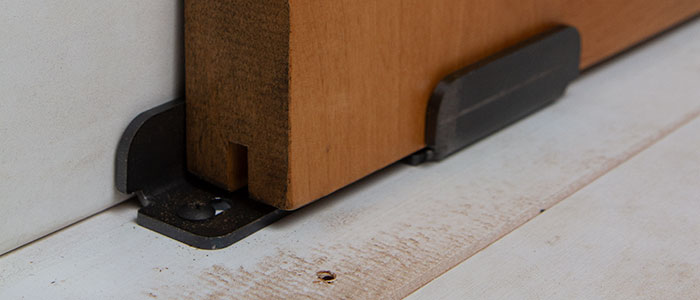
6. Sliding Door Locks and Handles
Sliding barn doors can be locked, and handles often add a nice finishing
touch. The lock and handle are often two separate pieces and, together, give you a sliding door that looks great and
provides an extra layer of privacy.
Function: There are several
types of
barn door
locks and handles available for your sliding door. Latch locks will simply latch your door closed to provide
privacy, but won’t provide much in the way of security. If you want to securely fasten the door with a lock, you’ll
want interior hardware that provides a secure locking mechanism. When it comes to handles, they’ll all function
similarly and aid you in opening the door by pulling on it. These handles are not dummy handles, even though there
is no knob to twist to open the door. The difference is that barn door handles still serve a purpose because you
need it to pull the door open.
Color: Handles and locking hardware
come in the same color options as other interior hardware. You can pick from options like stainless steel trim,
polished brass, oil rubbed bronze, matte black, fire engine red, gold, and other colors, depending on your style
preferences.
Design: Handle styles can be matched to complement the
overall look and feel of your sliding door. Choose from straight, thick handles or thin handles twisted in a
screw-type pattern. Some handles feature scrollwork, while others are sleek and elegant.
Size: Door handles and locks should be measured appropriately, depending on the size and
width of your door. Be sure to follow manufacturer instructions to measure correctly and choose the right
combination of lock and handle.
Is Interior Door Hardware Universal?
The simple answer to this question is no, interior door hardware is not
universal. The reason for this is that interior doors themselves aren’t universal. While some door measurements are
certainly “standard,” with certain sizes readily available from numerous manufacturers, there is no “universal” size
to be found.
What are some standard-sized hardware items you might find? You’ll
typically find doorknobs and deadbolts that are somewhat standard in sizing. This means the lock or knob itself will
come in a common measurement, and the opening in the door for each piece of hardware is sized accordingly. In
general, the deadbolt and doorknob boreholes (the place you insert the knob or lock into the door) is typically 2
and 1/8 inches in diameter.
We say that there isn’t a “universal” size, however,
most interior doors come with standard measurements, making it easier to find that “just right” piece of hardware to
complete the door. The important thing to note when choosing any type of interior door hardware is that you should
always measure before you purchase. It’s not always guaranteed that your door will be a “standard” size. And while
you may be able to return hardware items that don’t fit, you don’t want to make an enjoyable remodeling project turn
into a hassle.
Measure the doorknob borehole and the depth of the door. Do it twice
to make sure you’ve got it right and then note down the numbers so you’ll have them on hand while you browse for
your new hardware pieces.
Interior Door Hardware Completes the Home Design of Your Dreams
When you’re getting ready to design the home
of your dreams, you probably think about sitting down and working your way through paint colors, major design
concepts, furniture, décor, and hardwood flooring. Interior door hardware might be the last thing on your mind when
you’re getting ready to bust out the hammer and take out a few walls. But often, it’s the small things that are the
most important pieces of the home renovation or redecorating puzzle. This is certainly true of interior door
hardware.
There are a lot of things to think through before purchasing the perfect
hardware piece for your interior doors. You’ll need to take time to consider the style and decor elements you want
to incorporate into your home, but by taking your time and working through each of these elements, you’ll be able to
put the finishing touches on the updated look you envision for your home. And if you have any questions on which
interior door hardware will work best for your home, Rustica’s design experts are more than happy to help!
Once you have everything just the way you want it, you’ll love the finished
look. Nothing quite beats that moment when you get to take a step back, look at your handiwork, and breathe that
sweet sigh of satisfaction after a job well done.
Featured Interior
Doors
|
Chevron Barn Door
|
Modern Cottage Interior Doors
|
Traditional French Barn Door
|
